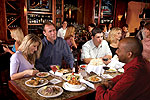 Answer Your Phone (and emails) - It's Could Be Opportunity Calling
Answer Your Phone (and emails) - It's Could Be Opportunity Calling
Once upon a time, in a time not so far away, real people answered their phones; read and personally responded to their mail and were sincerely apologetic for not responding in a prompt manner. Those days are gone. Today, we have techno-barricaded ourselves from the world. We let voice mail and email inboxes act as filing cabinets of communication to be dealt with when we have a moment or when they have been filled to capacity. In that time far away, businesses used to answer their own phones. Yes, real people on the other end who would take our calls without going through a "Press 1 for this or press 2 for that". Those were the days.
There is a point here. Actually more than a point, an opportunity. In this ADD, impatient world we live in, businesses that actually have real people responding to real people in a timely manner would create a strategic competitive advantage. What a unique selling point! Call us and you will speak with a real person. We promise. It is a story worthy of media coverage.
Here is an example of what I am talking about. Perhaps you can relate.
I dial the mobile number of Jane Doe, VP of Marketing for the Acme Group, who gave me her card at an industry luncheon and said to call her.
"This is Jane Doe. I am sorry I cannot take your call. At the tone, leave your name and number and I will get back to you as soon as I can." BEEP
I leave a message.
I dial the corporate number for the Acme Group from her card.
"Thank you for calling the Acme Group. If you know your party's extension, please dial it now or press "1" to access the company directory."
After listening to the choices, I enter the extension of Jane Doe.
"This is Jane Doe, Vice President of Marketing. I am sorry I cannot take your call. At the tone, please leave your name and number and I will get back to you as soon as I can. If you need immediate assistance, dial extension 549 and ask for my assistant, Mary." BEEP
I leave a message and dial 549.
"This is Mary Brown. I am sorry I cannot take your call. At the tone, please leave your name and number and I will get back to you as soon as I can." BEEP
I leave a message.
I send an email to Jane Doe.
I get an instant reply.
"This in an auto-reply. I am out of the office until next week and do not have access to email. If you need immediate assistance, call my assistant, Mary, at 404-555-6000 EXT 549."
Time passes.
I follow up both by phone and email to Jane and her assistant, Mary.
More time passes.
Of course, this is a fictitious example, but it could represent one of any number of real examples in today's world of business to business communications. Are Jane and Mary too busy or am I just not important enough to get a timely response?
By the way, it happens to consumers as well.
I recently called an airline to book a flight.
"Thank your for calling Sky Airlines (not the real name). For English, press 1. For Spanish, press 2." I press 1.
"If you know your frequent flier number, enter it now. If not, press 3" I press 3.
If you are traveling within the next 24 hours, press 4. If not, press 5" I press 5.
If you are using frequent flyer miles , press 6. If not, press 7" I press 7.
If you are confirming a reservation, press 8. If not, press 9" I press 9.
"Please hold for the next available operator."
Music
"Thank you for holding. All our operators are busy serving other customers. Your business is important to us. Please continue holding."
More music. I hung up.
Is anybody home? Does anyone want my business?
 All Elements Are Keys To Digital Brand Success
All Elements Are Keys To Digital Brand Success





